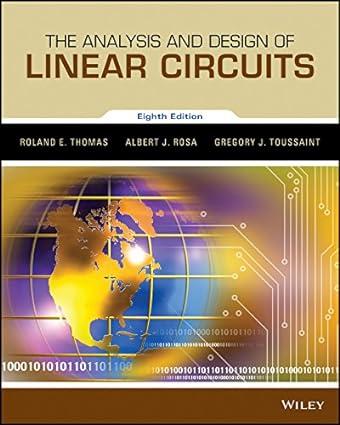A transformer transfers signals or power from one circuit to another strictly by magnetic induction without conductive
Question:
A transformer transfers signals or power from one circuit to another strictly by magnetic induction without conductive paths between the circuits. Such circuits are said to be electrically isolated since there is no electric current flowing directly from one to the other. Any transformer provides isolation, as well as the common functions of changing voltage levels or matching impedances. Transformers that have isolation as their primary purpose are called isolation transformers.
One such purpose is the elimination of what are called ground loops. In a circuit diagram, all ground symbols are assumed to be at the same potential because of an implied zero-resistance connection between them. In reality, this may not be the case and Figure 15–21 illustrates how this results in a ground loop. A ground loop is a closed conductive path formed in part by an intentional connection between the two circuits and in part by an unintentional (and uncontrolled) connection formed when two “grounds” are not at the same potential.
For example, if circuit B in the figure is a metal ship moored in port and supplied with ac power from an onshore source in CircuitA. The ship’s ground (its metal structure)
may not be at the same potential as the “earth” ground of the onshore source.
This forms a ground loop and allows an errant return current to flow through an uncontrolled path. This current causes undesirable galvanic corrosion when it passes through the interface between the water and the ship’s metal hull. One solution is to introduce isolation transformers in the intentional ship-to-shore connections thus electrically isolating the ship and eliminating the conductive paths needed to form ground loops.
Isolation transformers come in many sizes for different applications. They are often one-to-one ðn = 1Þ transformers since their purpose is electrical isolation rather than changing voltage levels. For example, Figure 15–22
(a) shows a schematic of a 16-pin dual inline package containing three tiny one-to-one isolation transformers and Figure 15–22
(b) shows a photo of an actual device. Such a package finds application in high-speed digital circuits in part because it is compatible with PC board manufacturing methods.
The typical mast antenna in Figure 15–23 offers an interesting application of an isolation transformer. The mast is made of conductive metal and is mounted on a


non conductive base that isolates it from earth ground. The mast is driven by a radio frequency (RF) source that may raise its metal structure to several hundred kiloVolts above ground potential. Because of its height, a mast antenna is equipped with attached air-traffic obstacle warning lamps that are powered by ordinary 60-Hz ac power. The wires carrying ac power to the lamps are of necessity exposed to the antenna’s radiated fields. The RF currents induced in these wires naturally seek a conductive path to earth ground in the lamp power source. To avoid this diversion of RF radiated power, an isolation transformer is inserted between the lamp power source and the circuit bringing power to the lamps. This type of isolation transformer requires special design features and is usually called an Austin transformer, so named for an early patent holder, Arthur O. Austin.
Step by Step Answer:

The Analysis And Design Of Linear Circuits
ISBN: 9781119235385
8th Edition
Authors: Roland E. Thomas, Albert J. Rosa, Gregory J. Toussaint





